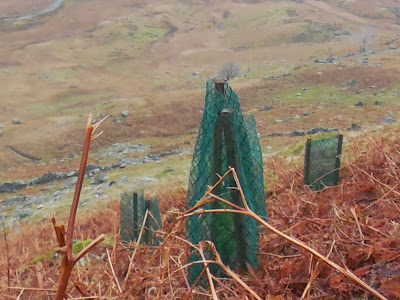Juniper, a long lived and slow growing conifer tree, is in decline in the U.K. Cumbria, even with the most extensive stands in England, is no exception.
As one of the first tree species to "colonise" Cumbria after the last ice age, juniper has been a feature on this landscape ever since.
Juniper is adapted to extreme weather conditions, and thrives on the poor soil of the Lake District fells.
Many of the trees in Cumbria are now very old; some stands have trees upwards of 200 years old. Unfortunately, the few seedlings that they do manage to reproduce are heavily grazed by sheep, rabbits and deer.
Juniper's poor regeneration is of such concern, that it has been included in the Biodiversity Action Plan as a priority species for Cumbria.
 |
| National Trust Ranger digging out and scraping away the turf, prior to planting a seedling. |
Juniper is a dioecious (two houses) tree species. This means that the male and the female flowers grow on separate trees. In effect, individual juniper trees are either male or female.
A reasonable number of both male and female junipers, able to produce viable seeds, are needed at any given site to ensure successful regenerations.
A reasonable number of both male and female junipers, able to produce viable seeds, are needed at any given site to ensure successful regenerations.
Funding from the High Level Scheme has allowed for the planting of 500 seedlings on Doup Crag, high above Troutbeck Park Farm, to hopefully boost numbers here over the long term.
 |
| National Trust Land Rover with the plants and materials. |
 |
| Using the power barrow to take the tools and materials on the next leg of the journey. |
 |
| The quad bike and trailer also being used to transport the juniper seedlings, stakes and mesh guards. |
 |
| This is the point where it is too difficult for the quad bike to go any further. Everything has to now be manually carried up the long, steep slope . |
 |
| Clambering up into the mist with bundles of stakes and mesh guards. The designated planting site is still some distance away..... |
 |
| A young Juniper....approx 3 years old newly planted into bare ground. The turf has been stripped back from around where the juniper has been planted. |
 |
| Junipers packed around with straw in storage box, prior to being planted. |
 |
| Juniper protected by plastic mesh guards. |
Juniper is an important habitat:
It supports, or is host to over 40 types of insects, including the Juniper Carpet Moth. The caterpillars feed exclusively on juniper. Larvae of the Juniper Berry Miner Moth feed on juniper seeds.
Juniper's dense prickly foilage provides good cover and protection for nesting birds.
The Ring Ouzel, an upland bird of the thrush family, feeds up on ripe juniper berries before its Autumn migration to Southern Spain, or the Atlas Mountains in North West Africa.
Various schemes, aimed at conserving juniper, will hopefully safeguard the long term future of this threatened species.

















































